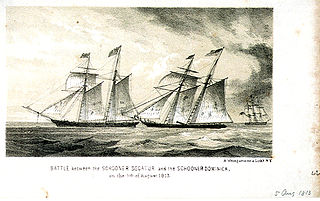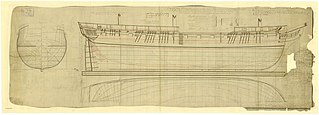
HMS Saturn was a 74-gun third-rate ship of the line of the Royal Navy, launched on 22 November 1786 at Northam. The vessel served during the Napoleonic Wars with the Channel Fleet, taking part in the 1801 Battle of Copenhagen. With the beginning of the War of 1812, Saturn was modified to become a frigate designed to take on large American vessels of that type. Saturn was deployed as part of the blockading squadron of New York City from 1814 to 1815. From 1825, the vessel was in harbour service and was broken up in 1868.
HMS Pictou was a 14-gun schooner that the Royal Navy captured in 1813. She served briefly on the Royal Navy's North American station, capturing one or two merchantmen before the American frigate USS Constitution captured her during the War of 1812.
HMS Highflyer was originally an American privateer schooner built in 1811. As a privateer she took several British vessels as prizes. The Royal Navy captured her in 1813. She then participated in several raids on the Chesapeake and coastal Virginia before the Americans recaptured her later in 1813.

HMS St Lawrence was a 14-gun schooner of the Royal Navy. She had been built in 1808 in St. Michaels, Talbot County, Maryland for Thomas Tennant and sold to Philadelphians in 1810. During the War of 1812 she was the US privateer Atlas. The UK captured her in 1813 and renamed her St Lawrence. The US privateer Chasseur recaptured her in 1815, and then HMS Acasta re-recaptured her.
HMS Anaconda was an 18-gun brig-sloop of the Royal Navy during the War of 1812. She was cruising as an American privateer until sailors from HMS Sceptre captured her in 1813. She served briefly in the Royal Navy during the later stages of the War of 1812, especially at the Battle of New Orleans, before being sold in Jamaica in 1815.

HMS Mosquidobit was the Chesapeake-built six-gun schooner Lynx that the British Royal Navy captured and took into service in 1813. She was sold into commercial service in 1820 and nothing is known of her subsequent fate.
HMS Whiting was a Royal Navy Ballahoo-class schooner of four 12-pounder carronades and a crew of 20. The prime contractor for the vessel was Goodrich & Co., in Bermuda, and she was launched in 1805. She was a participant at the Battle of Basque Roads. A French privateer captured her at the beginning of the War of 1812, shortly after the Americans had captured and released her in the first naval incident of the war.
HMS Shelburne was the American letter of marque schooner Racer, built in Baltimore in 1811 and captured by the British in 1813. She served on the American coast, capturing the American brig Frolic. She also captured some merchantmen and was sold in Britain in 1817.
HMS Whiting, built in 1811 by Thomas Kemp as a Baltimore pilot schooner, was launched as Arrow. On 8 May 1812 a British navy vessel seized her under Orders in Council, for trading with the French. The Royal Navy re-fitted her and then took her into service under the name HMS Whiting. In 1816, after four years service, Whiting was sent to patrol the Irish Sea for smugglers. She grounded on the Doom Bar. When the tide rose, she became flooded and was deemed impossible to refloat.

HMS Dominica was the French letter of marque schooner Duc de Wagram, which the British captured in 1809 in the Leeward Islands and took into the Royal Navy in 1810. The American privateer Decatur captured her in 1813 in a notable single-ship action. However, Majestic recaptured her in 1814. She was wrecked in 1815
Grecian was an American schooner launched in 1812. During the War of 1812 she received a letter of marque. The Royal Navy captured her on 5 February 1814 and took her into service as HMS Grecian. She was sold in 1822. In 1823 she became a merchantman. In 1824 the Chilean Navy captured her, but she escaped, and thereafter may have served for a time as a Spanish privateer. After the end of the Peruvian War of Independence she apparently returned to more conventional pursuits and was probably lost in 1829 though she was still listed in 1830 as sailing between London and Lima.
HMS Pictou was the American letter of marque schooner Zebra that the Royal Navy captured in 1813. The Admiralty purchased her in 1814 and she served on the North America station during the War of 1812 before the navy sold her in 1818.
HMS Elizabeth was a French privateer schooner that the Royal Navy captured in 1805 and took into service under her existing name. She participated in an engagement and a campaign that earned her crews clasps to the Naval General Service Medal. She was lost with all hands in 1814 when she capsized in the West Indies.
HMS Nimrod was a brig-sloop of the British Royal Navy, launched in 1812. She spent her war years in North American waters where she captured one small privateer, assisted in the capture of another, and captured or destroyed some 50 American vessels. After the war she captured smugglers and assisted the civil authorities in maintaining order in Tyne. She was wrecked in 1827 and so damaged that the Navy decided she was not worth repairing. A private ship-owner purchased Nimrod and repaired her. She then went on to spend some 20 years trading between Britain and Charleston, the Mediterranean, Australia, and India. She was last listed in 1851.
HMS Plumper was launched in 1807. She captured three small American privateers early in the War of 1812 but was wrecked in December 1812.

HMS Barrosa was launched in 1812 for the Royal Navy and served during the War of 1812 during which she captured several prices. After the war she spent a decade or so (1823–1833) on harbour duties. The navy sold Barrosa in 1841.
HMS Redbridge was the French schooner Aristotle, built in America. The Royal Navy took her into service as HMS Redbridge in 1807 and renamed her HMS Variable in 1808. She was sold in 1814.
HMS Bramble was launched in Bermuda in 1809. She had a relatively brief and uneventful career before the Royal Navy sold her in December 1815. She became the mercantile Bramble, and was last listed in 1824.
HMS Tweed was launched in 1807. On the Jamaica station she captured two small privateers and several merchant vessels. On the North Sea station she captured one small privateers and several merchant vessels. She was wrecked on 5 November 1813 with the loss of more than half her crew.
HMS Cockchafer was a United States schooner, formerly named Spencer, that the Royal Navy (RN) captured and employed as a ship's tender. She captured two American armed brigs, one in a single-ship action. The Navy sold her in 1815.




